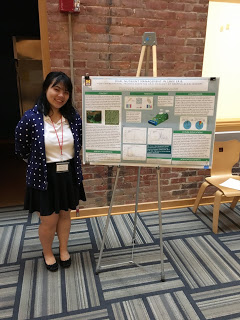January 8, 2019
Emily Chang, University of Michigan. 2018 DDCSP Scholar.
The work-in-progress that was the Biological Sciences Building was always eye-catching, its glassy exterior looking impressive, daunting, and… science-y. Throughout my winter semester of freshman year, it simply blended in with the daily landscape of people, plants, and the perpetual construction of Ann Arbor. I would take a cursory glance and bid it a good day from afar. From afar.
Imagine my surprise when I realized I would be spending a two-month chunk of my summer conducting research in that very building.
For context: I am aiming to be a social science major and the last time I had touched biology was years ago. I had not even a clue that the BSB would be finished by this time. In short, I was afraid. Very afraid.
But as part of the Doris Duke Conservation Scholars Program (DDCSP), which creates a space and community for diverse students interested in social justice and the environment to gather and grow together, I would be part of the Duhaime Lab. My project studied the viral ecology of Lake Erie’s harmful algal blooms (HABs). Perhaps my cool and casual usage of the previous terms belies my (mostly self-imposed, in hindsight) rough start, but within a few short weeks, I think I had come a long way – with many thanks and endless gratitude to my research mentors, fellow scholars and friends, and the program staff.
Perhaps more seasoned EEB-ers will be familiar with all this: the clusters of the cyanobacteria Microcystis that form HABs produce the toxin microcystin, and pose an enormous public health, economic, and environmental issue. Nitrogen and phosphorus are two highly influential nutrients to blooms, leading to a need for effective dual nutrient management. Viral lysis is responsible for much cell mortality and thus bloom decline, but can cause nutrients to recycle into blooms again. Agricultural runoff heavily contributes to the nutrient load to Lake Erie, and the HABs that consequently develop adversely affect the lake and the surrounding community. The current scope of existing policies do not adequately reflect current scientific evidence, and this gap must be closed to create more effective and inclusive regulations to better address the challenges of tomorrow.
It was here where I found where I could bridge my interest in public policy and health to this seemingly enigmatic field known as…. science. Finding this connection provided me with a direction that I could move towards, probe, and enjoy exploring. Despite being able to easily produce that previous paragraph of information, I cannot ever forget that paragraph of information was also hard-won after two months well spent.
My first few days began with awkward loitering, waiting for someone with access so I could (smoothly and inconspicuously) slip in. Then, after getting settled at a pristine and beautiful cubicle next to a perhaps even more pristine and beautiful lab, I would start reading. And reading, and reading, and reading. Although the intense and voracious reading contradicts the classic scientist image of streaking plates and carefully pipetting substances, it was necessary to provide context to understand the research. Eventually, I graduated from perusing an introductory biology textbook to full-fledged academic papers. My enjoyment of the subject matter grew proportionally with my comprehension, and I found myself looking forward to returning to the lab to hopefully learn something new everyday.
It was as if a phage of knowledge came and injected its DNA into my mind, which started synthesizing this information as if it was mine all along (a microbio metaphor!).
This newly synthesized me could walk up to the BSB boldly with my access-granting MCard, and after sitting at the still pristine and beautiful cubicle, I began reading and reading again. Although this reading is different: I was no longer filling a deficit, but using my current base of knowledge to progress. Progress towards more confidence, more comprehension, and more cohesion of my realms of interest before and currently. I am happy to report that I – with everyone’s help – successfully developed a poster outlining HABs and their policy implications for the DDCSP capstone. And hey, I ended up learning how to streak plates and pipette too!

While I still have no claim to being a bonafide microbiologist, I am more comfortable than I ever thought I would be discussing viral ecology. All things considered, my jealousy-inducing EEB lanyard and excitement for the environmental factors that cause viral lysis in bacterial hosts are awfully convincing.
Dare I say, the passion for viral ecology has been quite infectious this summer!
[This blog post was originally posted on: http://eeblog.lsa.umich.edu/2018/08/an-infectious-summer-of-fun-and-growth.html?m=1]